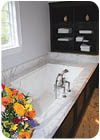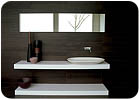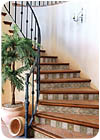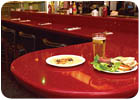
Local travertine and Pietra Serena were combined with brick for much of the medieval architecture in Lucignano, Italy. This is true of the city’s main arches, including Porta S. Giusto.

The
Rocca, or Cassero Senese, stands among the town walls as the centerpoint of the
city’s defense. Conceived by architect Bartolo Bartoli and made of local stone,
the Rocca has a square shape and projects an image of strength above the main
public square.

The
Rocca can be seen at multiple points throughout Lucignano.
A wide variety of tile shapes and sizes are available today - offering endless options in both residential and commercial settings. Standard square and rectangular tiles - both stone and ceramic - are being mixed and matched to form modular wall and floor patterns, while circular and hexagonal pieces can provide a more whimsical effect. And the popularity of mosaics continues to gain momentum, as these tiny stone and tile pieces are used for decorative borders, backsplashes and medallions - as well as to clad entire walls and floors.
An extensive line of finishes also contributes to the look of new products in today’s market. Polished and honed stone tiles remain staples, but silky satin finishes and rough-cut textured pieces are ideal for bringing movement to a space. Ceramic and porcelain tile lines are also offering a selection of finishes - catering to the multiple needs of designers and homeowners.
Inspiration for new tile designs is coming from many influences, including fashion, fabrics and even food. Tile manufacturers are mimicking colors, textures and patterns seen in these other high-power industries. Incorporating elements from these outside influences not only adds to the overall aesthetic value of the product, but also brings more dimension to each tile collection.

The
Collegiata di San Michele Arcangelo also utilizes native travertine, along with
brick and Pietra Serena. It was rebuilt in 1593, although only the lower
portion of the facade was finished. The portal was made by Pietro Antonio
Morozzi in 1715, and the flight of steps was made by Andrea Morozzi, who is
also thought to have made the bell tower. The church has a Latin cross plan
with a nave and a hemispheric dome.
Setting a Tone
With continual technological advances being made in the production process, the improvements in the quality of new collections hitting tile showrooms is evident. Today’s products are offering more than just function, and they are not only molding designs with their shapes, sizes and colors. Rather, their inherent three-dimensional qualities are capable of setting a mood in a room - whether its tranquil, chic or casual. When it comes to the kitchen, stainless steel appliances have become quite the rage. The sleek look of stainless stoves, refrigerators and dishwashers sets the tone for a more contemporary design. Glimmering glass mosaics and chic metallic tile are ideal complementary pieces in these spaces - particularly for backsplashes or accent borders in floors.But even though glass, metal and stainless steel are viewed as more contemporary materials, if strategically matched with more subdued floor and wall tiles, the design doesn’t take on an ultra-modern appearance. Pairing tumbled stone or neutral-colored porcelain with edgier materials softens the look of a room - creating a nice balance in the design.
Another primary point of interest in interior design is the countertop and vanity. While polished granite is often a material of choice for these applications, white marble has also become a well-accepted option lately. Whether polished or honed, white marble often has a softer feel than granite. Combined with rich woodwork, the contrast between light and dark creates a striking look of elegance in any kitchen or bathroom. Using white marble in a space can also conjure an Old World feel. The material can be reminiscent of European architecture and design - particularly when considering a stone such as Carrara White marble from Italy, which was Michelangelo’s timeless material of choice. White marble countertops or vanities can create a classic design, yet if combined with other materials, can still provide a unique overall appearance.

With
a population of nearly 3,500 that caters primarily to the tourist trade,
Lucignano proudly celebrates its medieval roots, with medieval banners adorning
walls and buildings throughout the town.
Accenting a Space
As it has been mentioned, tile manufacturers have concentrated their efforts on developing top-of-the-line products that inspire innovative design. In addition to the abundance of colors, shapes and sizes, there are also countless decorative pieces on the market today.Coordinating trim pieces are being produced in ceramic, porcelain, glass and metal to complement floor and wall tiles. These trim pieces take the form of rope borders, corner pieces or small decorative accent tiles, which are a great way to break up a monochromatic floor or wall pattern.
Hand-painted tiles are also another way to spice up a design. Typically, these tiles feature vibrant colors, which can add a punch to any space. Ideal for accenting fireplace surrounds, backsplashes or stair risers, the rich elegant look of hand-painted tiles has the ability to enhance the overall design.
In addition to ceramic tile, there is also an assortment of decorative stone products available. Skillfully chiseled stone pieces are being used for borders, chair rails and moldings. These pieces can be polished or honed, depending on the look desired.
Also, stone tiles with images hand-printed onto them present another design option. Decorative tiles such as these can be pieced together to form murals in applications such as kitchen backsplashes or office lobbies. Additionally, individual pieces can be used as accents or to form borders.

Innovative Solutions
For those seeking something eye-catching and truly different, there is also a range of tile collections available that have very distinctive characteristics that set them apart from the rest. As a result of modern technology, tiles are being made to resemble the look of fabrics, wood and elements of nature.Some tiles even feature raised surfaces - outlining a detailed motif and providing the tile with depth and texture. This technology allows tile to bring the softness of silk or the delicateness of a flower to any type of residential or commercial application.
On another note, tile that mimics the look of wood is also being used more frequently in design. And in recent years, there has been an apparent improvement in the development of these product lines. Not only is the grain and color more realistic, but the sizes now better represent the look of hardwood flooring.
Among the advantages of using wood-look tile as opposed to hardwood is that it can be installed in areas that are subject to getting wet, such as bathrooms, spas and pools. Also, it eliminates concerns of scuffing and scratching - particularly important in high-trafficked spaces.
Another innovation that is being implemented more in today’s designs is quartz surfacing. There are several leading manufacturers who are heavily marketing the product as an alternative to natural granite and marble countertops. In addition to offering colors that resemble the appearance of natural stone, quartz surfacing is also available in an array of vibrant colors.
For homeowners who are looking to make a bold statement in their kitchen with a fire engine red countertop or lime green bathroom vanity, quartz surfacing meets this desire. The broad color palette also lends itself to the design of trendy nightclubs or chic boutiques. Additionally, the consistent patterning of the material provides comfort to those who are leery of the varying color and veining of natural stone.
With so many stone and tile products on the market today, there is a material to suit every taste and design requirement. And with the constant focus on research and development, the selection will only continue to grow and evolve - making for many more inspirational designs.